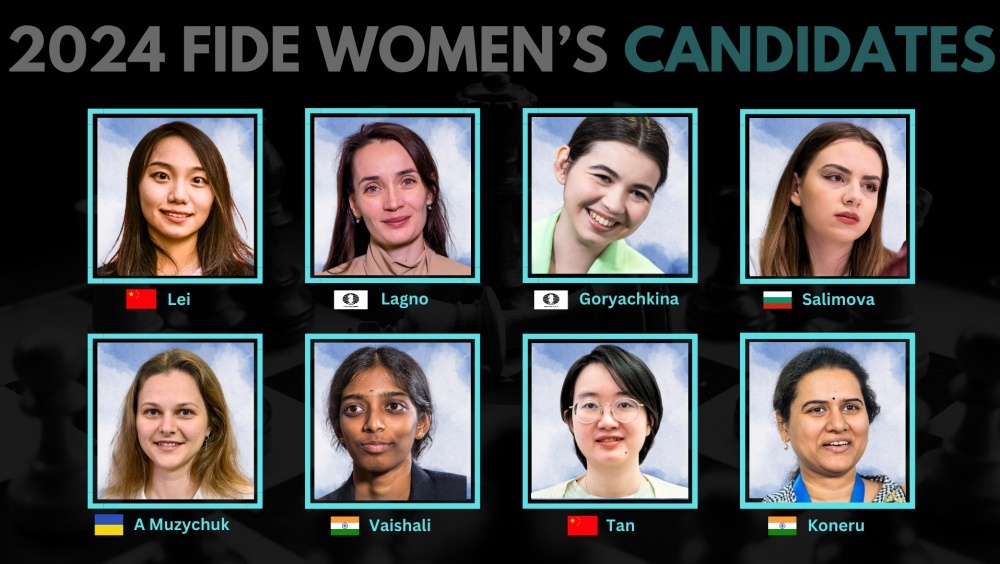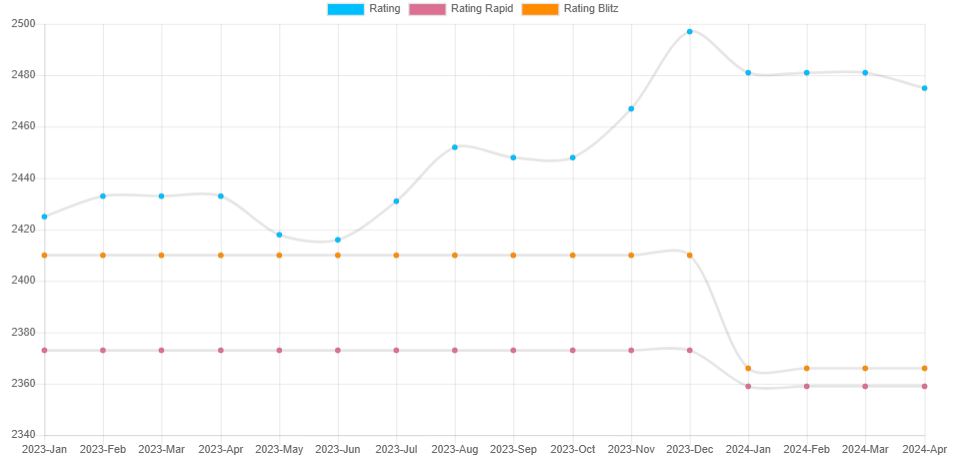Cover photo taken from the official FIDE Website
Table of Contents
Introduction
The upcoming Candidates Tournament 2024 is not only notable due to the fact it will be the first Candidates tournament to be held on North American soil.
For the very first time, it will be held alongside the Women’s Candidates Tournament 2024, in which some of the best female players in the world will be fighting for first place and the chance to qualify for the Women’s World Chess Championship and challenge Ju Wenjun for the title of Women’s World Champion.
Since the beginning of that tournament is also just a couple of days away, I thought it would be a nice idea to follow up on my previous article on the Candidates Tournament 2024 and make an even bigger fool of myself by trying to predict the outcome of the Women’s Candidates Tournament 2024.
I hope you will enjoy it!
Woman’s Candidates Tournament 2024
Regulations and the Format
The regulations and the format of the Women’s Candidates Tournament 2024 are fairly similar to its “Open” counterpart. It will be held at the exact same time (3rd-23rd April) in the exact same place (Great Hall, Toronto, Canada) and will have exactly the same schedule:
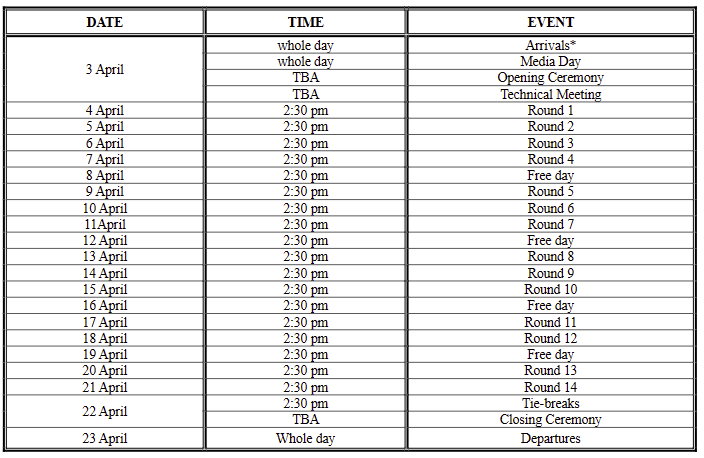
(Official Schedule of the Women’s Candidates Tournament. You can notice that the rounds start at the exact same time – 2:30 PM – as in the Candidate Tournament. Free days also coincide. Source: Official Regulations of the Women’s Candidates Tournament 2024)
The tournament will also be held using the double round-robin format and will feature the same tiebreak system. The only fundamental difference is related to the time control, which will be 90 minutes for the first 40 moves, followed by 30 minutes for the rest of the game, with an increment of 30 seconds per move starting from move 1. 1
I don’t fully grasp the reasoning behind having two fundamentally different time controls in two tournaments held alongside each other. One can’t even claim that they wanted to make the time control for the Women’s tournament shorter, 2 since 90 minutes + 30 seconds of increment for the first 40 moves is approximately as long as 120 minutes + 0 seconds of increment for the first 40 moves. I genuinely can’t think of a single good reason why both tournaments didn’t feature the same time control. 3
In any case, I do hope we will see some high-quality games and entertaining chess in both events, in spite of the time control differences.
List of Participants
Time control is not the only big difference between the Women’s Candidates Tournament and the Candidates Tournament. Qualification paths for both events were also substantially different, due to the existence of the Grand Prix Series in the Women’s section and Grand Circuit in the Open section. According to the Official FIDE Regulations for the Women’s Candidates Tournament, players qualified based on the following criteria:
(Qualification regulations for the Women’s Candidates Tournament 2024. Source: Regulations for the Woman’s Candidates Tournament 2024, taken from the FIDE Handbook)
According to the regulations, 8 qualified players are, as follows:
- Lei Tingjie – runner-up from the Women’s World Chess Championship 2023
- Kateryna Lagno – winner of the Women’s Grand Prix 2022-2023
- Aleksandra Goryachkina – runner-up of the Women’s Grand Prix 2022-2023
- Nurgyul Salimova – runner-up of the Women’s Chess World Cup 2023
- Anna Muzychuk – third place winner of the Women’s Chess World Cup 2023 4
- Vaishali Rameshbabu – winner of the Women’s Grand Swiss 2023
- Zhongyi Tan – third place winner of the Women’s Grand Swiss 2023 5
- Humpy Koneru – the highest-rated player that didn’t yet qualify on 1st of January, 2024. 6
Assessment of the participants’ chances
After introducing you to the regulations and the players, I will now follow the procedure from the article on the Candidates Tournament by estimating each of the participant’s chances and predicting the outcome of the event.
In my analysis, I will be focusing on three parameters:
- Strength/Recent Form
- Nerves/Experience
- Head-to-head score against the other participants
Aleksandra Goryachkina
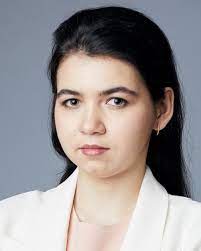
Strength/recent form
Aleksandra Goryachkina is generally regarded as one of the stronger players in this event. She is not only one of only 6 female players who crossed 2600, 7 but she is also a former winner of Candidates Tournament and World Chess Championship Challenger. Since she is still comparatively young (born in 1998), she should not be at the age where her strength starts declining and should have every hope of doing well and winning the entire event.
With that being said, even though at some point she looked like the next Judit/Hou Yifan, 8 it has never somehow materialized. Ever since her peak of 2600 back in 2021 and her defeat against Ju Wenjun in the World Chess Championship match, Goryachkina hasn’t been the same dominant force in female chess she used to be.
Don’t get me wrong, she is still a very strong grandmaster/player. But since 2022, her rating has been gradually declining from 2600 to 2553, where it currently stands.

(Goryachkina’s rating chart since January 2022. Source: Goryachkina’s FIDE Profile)
Naturally, in this period, Goryachkina’s results were far from impressive. To name a few:
- In August 2022, she lost 20 rating points by drawing all of her games in the Russian Higher League
- In December 2022, she lost the semi-final Candidates match to Tan Zhongyi
- In March 2023, she didn’t have a particularly good result at the European Individual Championship 2023
- In April and May of 2023, she didn’t have the most successful performance at the Women’s FIDE Grand Prix, where she lost some rating and failed to secure the Candidates spot
- In November 2023, she had a bad result at FIDE Grand Swiss 2023, scoring 6/11 and losing a further 13 points
Her only good results in the recent past are a 10-rating point gain in the Russian Superfinal for Men in October 2023 and the victory at the Women’s World Cup 2023. Thus, I think it is fair to say that Goryachkina has been on a “decline” for a while and that she will not arrive in Toronto at the height of her powers.
Nerves/Experience
On the other hand, even though she is still relatively young, Goryachkina is already extremely experienced, having played top (female) events for almost a decade and already having a win in the Candidates and participation in a World Championship match under her belt.
On the other hand, even though GM Rafael Leitiao mentioned he considers her to have strong nerves in the most recent episode of the Perpetual Chess Podcast, I am not 100% sure I fully agree. On one hand, she did win a must-win game in the 2020 World Chess Championship match against Ju Wenjun. But on the other hand, she also suffered back-to-back losses in games 9 and 10 in a seemingly winning position. Her loss to Tan Zhongyi in the 2022-2023 might also be attributed to nerves, although it is hard to tell whether it had more to do with her declining form (and the fact Tan played superbly).
Admittedly, this is precisely where experience comes in. Whether Goryachkina’s nerves are an asset or liability and whether these past failures will help her control them better – remains to be seen.
Head-to-head score against the other participants
Goryachkina’s head-to-head score against the other participants is as follows:
- Goryachkina – Tingjie: +0-1=1
- Goryachkina – Lagno: +2-0=9
- Goryachkina – Koneru: -0+1=2
- Goryachkina – Tan: +3-3=4
- Goryachkina – Muzychuk: +1-1=9
- Goryachkina – Vaishali: +0-0=3
- Goryachkina – Salimova +0-0=3 9
From Goryachkina’s head-to-head scores, we can observe/conclude the following:
- She has played a remarkably low amount of games against four participants in the tournament. I was particularly surprised by the fact she only played two games against Lei Tingjie (back in 2015 and 2016) and only three against Koneru, given that all three have been top female players for a while.
- I was less surprised by the relatively low amount of games against Vaishali and Salimova given their youth. But I was somewhat surprised Goryachkina wasn’t able to demonstrate her superiority or obtain a plus score.
- Goryachkina’s encounters against Lagno and Muzychuk feature a relatively high percentage of draws. Although she does have a 2:0 plus score against the former.
- Goryachkina’s head-to-head score against Tan Zhongyi is remarkably bloodthirsty. In recent times, Zhongyi does seem to be on the better side of it, given her victories in the 2022 Candidates Match and in the 2023 FIDE Grand Swiss. Although Goryachkina got her revenge in the 2023 FIDE World Cup.
Thus, the head-to-head score against other participants doesn’t particularly seem to go in Goryachkina’s favour. So far, she has not been able to demonstrate her superiority against “lower seeds” and has also had some difficulties when facing players such as Lei Tingjie, Humphy Koneru and Tan Zhongyi. When you couple that with the fact she wasn’t in the best form in recent years, one might hesitate to consider her a favourite in the event.
Still given she is still very young and the highest-rated participant in the tournament, it would be also foolish to not consider her as a serious contender. The betting companies do seem to share that sentiment:
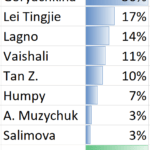
I contemplated a lot about whether her chances were higher than, say, Lei’s. 10 Due to her classical, positional, and solid style, I can’t see her losing many games and having a bad event. And I can easily see her winning enough games to win the entire event.
Ultimately, due to the fact Tingjie Lei has not played that much chess in recent years and that Goryachkina absolutely dominated the last Candidates tournament held using the round-robin system, I have selected her as the ultimate winner.
Although I heavily disagree with the betting odds. I don’t think she should be considered a favorite by such a large margin.
Tingjie Lei
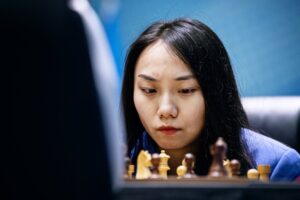
Strength/recent form
Tingjie Lei is generally regarded as one of the strongest female players in the world. With a rating of 2550, she is currently the 4th player on the women’s rating list. 11 She was one of the participants in the most recent Women’s World Chess Championship and is still comparatively young. 12
And while no sane person can doubt her class/playing strength, her recent form is much more difficult to gauge. For a very simple reason – in recent years, Lei Tingjie has played surprisingly little chess.
This is not an exaggeration. Since April 2020, Lei
- played a total of 4 events and 38 classical games
- didn’t play a single classical game between
True, these periods of inactivity/lack of practice don’t seem to affect her play. Lei performed well in virtually every event she participated in in the last four years:
- Women’s Grand Swiss 2021: 9/11, +30 rating points
- Women’s Candidates Match against Mariya Muzychuk: 2.5-1.5, +4.60 rating points
- Women’s Candidates Match against Anna Muzychuk: 2.5-1.5, +4.60 rating points
- Women’s Candidates Match against Tan Zhongyi: 3.5/5, +8.50 rating points
- Women’s World Championship against Ju Wenjun: 5.5/12, -3.80 rating points, losing by the narrowest of margins
But I would say Lei has thrived despite – not because of – her inactivity/lack of practice. Speaking historically, not playing before the Candidates tournament might not be the best strategy – as Firouzja’s result in the Candidates 2022 demonstrates. Whether it will affect Lei as well – remains to be seen.
Nerves/Experience
Even though she is still relatively young 15 Lei has experience playing at the elite level. In the recent cycle, she won three Candidates Matches and ultimately qualified for the World Chess Championship Match against Ju Wenjun, which she lost by the narrowest of margins. 16 My impression is that she has displayed very good nerves throughout these events. And even though one could take losing the final game of the World Chess Championship as evidence of the contrary, I do believe it speaks more about Ju Wenjun’s strong nerves rather than Tingjie’s weak ones. 17
Head-to-head score against the other participants
Lei’s head-to-head score against the other participants is as follows:
- Lei – Goryachkina: +1-0=1
- Lei – Lagno: +0-2=2
- Lei – Koneru: +0-4=0
- Lei – Zhongyi: 5-4=10
- Lei – Muzychuk: +1-0=3
- Lei – Vaishali: +0-0=0
- Lei – Salimova: +0-0=0
From Lei’s head-to-head scores, we can observe the following:
- Lei has a slight plus score against Goryachkina, Tan, and Muzychuk. The fact that she beat the last two in the previous Candidates cycle might theoretically be somewhat relevant (since it was also a high-stress situation).
- She also has a slightly more negative score against Lagno and Koneru. The latter, in particular, seems to be a very tough opponent for her, given that she has beaten her in every single classical game they ever played. However, three of these games happened way back in the day (one in 2013 Chinese Team Championship and two in the 2015 Women’s World Championship Knockout Tournament). Furthermore, in their last game, played in 2021, Lei blundered in an equal position.
- Lei hasn’t played a single classical game against Vaishali and Salimova. This is somewhat expected given that these two are relative “newcomers”, but it will be very interesting to see how their first encounters will develop in such an important and nerve-wracking tournament.
All in all, given that Lei is the second highest-rated player, that she now has World Chess Championship experience and that she won the last Candidates, it is hard not to consider her as one of the top two favourite, despite the comparative lack of practice and negative score against players such as Lagno or Koneru. I hesitated a lot between picking her or Goryachkina as the final winner, but have ultimately decided to go with the latter.
Humpy Koneru

Strength/recent form
Humphy Koneru is one of the greatest female players of all time. She has been one of the top female players for almost 20 years. 18 Back in 2007 (!!), she became the second female player to break the 2600 rating barrier and was the strongest female player in the world, until she eventually got overshadowed by Hou Yifan. Even today, her live rating of 2546 is sufficient for the 5th spot on the women’s rating list. And is not that far from Goryachkina’s 2553 and Tingjie’s 2550.
On the other hand, Koneru doesn’t arrive in Toronto in the best shape. In recent years, she has had a number of mediocre – or even outright bad – events, such as:
- Women’s Grand Prix 2023 – Third Leg, where she scored 4.5/9 and lost 9 points
- Cairns Cup 2023 where she lost 14 rating points 19
- Women’s World Cup 2023 where she got eliminated in round 3 by Bella Khotenashvili
Her most recent performance in the Graz Open 2024 A just a month ago20also wasn’t stellar.
In fact, I don’t think all these results can only be attributed to “bad form”. I think it is fair to say that Koneru is past her prime and is slowly declining. In the last few years, her rating went from 2586 to 2546.
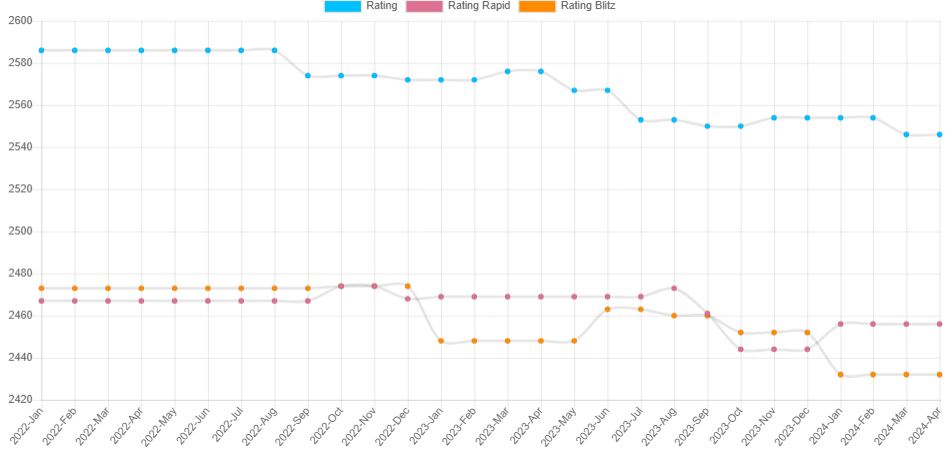
(Humphy Koneru’s rating progress since 2022. Source: Koneru’s FIDE profile)
Given that Goryachkina’s graph followed a similar trajectory, one might argue this in itself is not evidence of decline or being “past your prime”. 21 But when you also take the fact Koneru is the oldest participant in the tournament, one does feel it will be much harder for her to regain these points than for someone 10 years younger. 22 And that the term “past your prime” is much more applicable.
Nerves/Experience
As the oldest participant in the tournament, Koneru is not lacking in experience. Even though she has had several breaks from competitive chess, she never fully “went away” and has been competing at the top level for almost two decades. She previously participated in several World Championship Knockout Tournaments (2004, 2008 and 2010) and even played a World Chess Championship match against Hou Yifan back in 2011. 23
While only a madman would doubt her experience, her nerves might be a different kettle of fish. In the aforementioned episode of Perpetual Chess Podcast, GM Rafael Leitiao mentioned Koneru might be somewhat struggling in the nerves department. The most notable argument in favour of this evaluation is her dramatic loss to Anastasia Bodnaruk in the tiebreak of the 2023 World Rapid Championship, where Koneru was objectively the superior player on the board. One could also take her past failures at the World Championship Knockout Tournaments as evidence. Most notably her elimination in the 2004 edition when she lost to relatively lesser-known Russian player Ekaterina Kovalevskaya. 24
However, this sample size is rather small. Whether this evaluation is correct – and whether Koneru will be able to use her experience to control her nerves even if it is correct – remains to be seen.
Head-to-head score against the other participants
Koneru’s head-to-head score against the other participants is as follows:
- Koneru – Goryachkina: +1-0=2
- Koneru-Lei: +4-0=0
- Koneru-Lagno +3-2=1
- Koneru – Tan +1-0=1
- Koneru – Muzychuk +3-3=7
- Koneru – Vaishali +0-0=1
- Koneru – Salimova +0-0=0
From the head-to-head scores, we can observe the following:
- Koneru has the head-to-head scores going her way. She has a positive or neutral score against all of the other participants in the tournament.
- Against most of the players (Goryachkina, Lei, Tan), the plus score is minimal (+1). But in the case of Tingjie Lei, it is overwhelmingly in Koneru’s favour.
- On the other hand, given that she is significantly older than most of the other participants (apart from Lagno), these scores are not that surprising. One would expect an established player like Koneru to beat the players from the younger generation while they are still “on the rise”.
- Koneru has played only one game against the two youngest participants in the tournament.
All in all, even though it is probably nice to enter a tournament having a positive score against the other participants, I am not sure how relevant it will be. I think nerves, form, and general playing strength will be much more impactful on the final standings.
Considering all these factors, I do think that the general sentiment about Koneru not being the top contender, but having a legitimate chance to win, is reasonable. It is hard to put her in the same tier as Lei and Goryachkina, given that these two are both younger and slightly higher rated. But there are also no reasons to consider her chances any lower compared to say, Lagno, Muzychuk and Tan. If things go her way, she can definitely go all the way. But on average, I would expect her to end up somewhere in the middle of the pack.
Of course, where exactly in the middle was not so clear to me. Ultimately, I have decided to put her at the “bottom of the pack” – in the 6th place – purely due to her age and potential issues with her nerves.
Kateryna Lagno
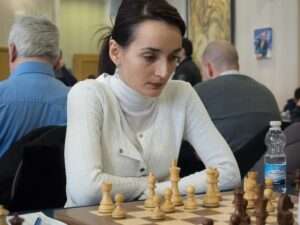
Strength/recent form
Kateryna Lagno is another great female player who has been consistently a part of the world elite for many years. Throughout her career, she has won several important titles (World Blitz Championship 2010 and 2018, World Rapid Championship 2014, and European Individual Women Championship 2008, to name a few), been a regular contender in Women’s World Chess Championship cycles, and even played the final match against Ju Wenjun in the 2018 edition, losing by the narrowest of margins. 25
With a live rating of 2542, Lagno is the 6th highest-rated female player in the world and fourth in this tournament. Furthermore, she is not lagging behind Goryachkina, Lei, and Koneru by much. Based on rating alone, she should have as good a chance as anyone to win the tournament and qualify for the match against Ju.
However – just like Goryachkina and Koneru, she doesn’t arrive in Toronto in the best shape of her life. Her most recent tournament performances weren’t brilliant – although they weren’t particularly bad, either:
- FIDE Women’s Grand Prix 2022-2023 – Third Leg: 5/9, lost 2 rating points
- FIDE Women’s Grand Prix 2022-2023 – Fourth Leg: 6/11, lost 6 rating points
- FIDE Women’s World Cup 2023 – Got eliminated in round 1 by Mary Ann Gomes, lost 6 rating points
- Russian Superfinal 2023 – scored 4/11, lost 4 rating points
Furthermore, given that she is the second oldest participant in the tournament, one can again make an argument she is – very much like Koneru – “past her prime.”
Nerves/Experience
As the second-oldest participant in the tournament, Lagno doesn’t lack in experience. As mentioned above, she has been competing at the top level for many years and has participated in numerous elite events.
Given her multiple victories in World Blitz and Rapid Championships, one could also make an argument her nerves are very good. However, she has also suffered some dramatic defeats in important events in recent years, such as:
- Losing with White in the 4th classical game of the 2018 Women’s World Championship Knockout Tournament, when a draw would have guaranteed her the title
- Losing to Tan Zhongyi in the quarterfinals of the previous World Championship Cycle, while missing a number of chances
- Losing to Mary Ann Gomes in World Cup 2023
I guess a certain decline of the nervous system is expected with age. We will see how Lagno will be able to handle it in this, high-stress, event.
Head-to-head score against the other participants
Lagno’s head-to-head score against the other participants is as follows:
- Lagno – Goryachkina: +0-2=9
- Lagno – Lei: +2-0=2
- Lagno – Koneru: +2-3=11
- Lagno – Tan: +4-2=4
- Lagno – Muzychuk: +1-3=13
- Lagno – Vaishali: +1-0=1
- Lagno – Salimova: +0-0=0
From the head-to-head scores, we can observe the following:
- Lagno has a positive score against Lei and Tan. Although a number of these games happened way back in the day. For example, her two wins over Lei happened back in 2018 in the World Chess Championship Knockout Tournament. While her wins against Tan happened in the 2016-2021 period. It is worth noting that Tan was the one who eliminated her in their quarterfinal match in the previous Candidates Cycle. 26
- Lagno has a negative score against Koneru, Muzychuk, and Goryachkina. The last one is particularly surprising, given that Goryachkina is much younger.
- Lagno hasn’t played that many games against Vaishali and Salimova, just like most of the other participants.
All in all, despite the small rating difference I wouldn’t exactly put Lagno in the same category as Goryachkina and Lei. She doesn’t arrive in Toronto in the greatest of shapes and her age and nerves might be a detrimental factor. True, it is not impossible to imagine her winning the tournament if things go her way. But on average, I would expect her to end up in the middle of the tournament table.
It was hard to decide where exactly to put her. But ultimately, I do think Tan might have slightly better chances.
Zhongyi Tan
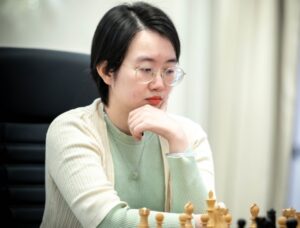
Strength/recent form
Zhongy Tan might be the most underrated and underestimated player in this tournament. For example, in a recent poll posted on the Twitter account Women’s Chess Coverage, no one picked Tan as her ultimate winner, which I genuinely found baffling – especially since Vaishali got 5 votes.
https://twitter.com/OnTheQueenside/status/1774098723758600484
After all – Tan has not only been one of the strongest female players in the world at least since 2017. But she is also the only participant in this tournament who has managed to become a World Champion, as she won the Women’s World Championship Knockout Tournament in 2017. True, her reign was not very long as she lost a very tight and close match to Wenjun Ju the next year. But we are still talking about the player of the World Chess Championship caliber.
As for her form – it is true that she “barely” qualified for the Candidates via FIDE Grand Swiss. But there she “delivered under pressure” and had a great tournament, scoring 7.5/11 and winning 8 rating points. And let’s not forget she barely missed the qualifying spot by ending in fourth place in the 2023 World Cup. Even an event such as the 19th Asian Games could be an indicator of good form despite the slight rating loss. If anything, scoring 7/9 after suffering an upset loss in the first round shows a lot of character and self-belief.
Nerves/Experience
As mentioned above, Zhongyi Tan is as experienced as it gets. World Championship Tournaments, World Championship Match, Candidates Tournaments. You name it – she has been there.
Tan also strikes me as a very stable player who is not particularly prone to being negatively affected by nerves. I think her performance in Grand Swiss 2023 alone is sufficient evidence, as it is not easy to deliver such a performance when you know it is your last chance for the Candidates.
True, she was bested by Ju Wenjun in the World Championship Match 27 and also by Lei Tingjie in the finals of the last Candidates. I think that tells more about the qualities of her opponents rather than her inability to deal with nerves.
Head-to-head score against the other participants
Tan’s head-to-head scores against other participants are as follows:
- Tan – Goryachkina: +3-3=4
- Tan – Lei: +5-4=10
- Tan – Lagno: +2-4=4
- Tan – Koneru: +0-1=1
- Tan Muzychuk: +3-2=9
- Tan – Vaishali: +0-1=1
- Tan – Salimova: +0-0=0
From Tan’s head-to-head scores, we can observe:
- Tan seems to be a rather fighting player, as her scores are rather bloodthirsty and have featured many decisive games.
- She does have an equal score with Goryachkina – but she did eliminate her in the last Candidates Cycle.
- She does have a slight positive score against Lei, although she did get beaten by her in the final of the last Candidates Cycle.
- She does have a slight positive score against Anna Muzychuk and a negative score against Kateryna Lagno
- She has played only a few games against Salimova, Vaishali, and Koneru. And while it is expected when it comes to the first two, it is somewhat surprising in the case of the latter.
All in all, given her class, her experience, and her ability to play well under pressure, I think Tan will do well in this tournament. I think she has equally good chances as Koneru and Lagno. But I also – perhaps somewhat subjectively – feel she has a higher chance to “surprise” and go all the way. Which is why I have decided to put her in the third place in my prediction.
Anna Muzychuk

Strength/recent form
Anna Muzychuk has been one of the strongest female players in the world for many years. 28 She is one of only six women to break the 2600 rating barrier. 29 She has been a constant contender in Women’s World Championship Cycles for more than a decade and came very close to winning it on several occasions.
With that being said, Muzychuk is another player whose peak happened way back in the past. Ever since April 2019, her rating has been sitting below 2550. The last few years, in particular, have been rather rough, as she dropped all the way to 2504 in March 2023, after a bad performance in the second leg of the 2023 Women’s Grand Prix Leg 2.
To be fair, Muzychuk must have been significantly impacted by the Russian invasion of her home country Ukraine. 30
However, ever since that “historical low”, she has been climbing up the ranks again. In late 2023, she had a string of very good performances:
- FIDE Women’s World Cup 2023: won 3rd place, 6 rating points, and qualified for the Candidates
- European Women Club Cup: scored 5.5/7 without losses, won 4.30 rating points
- FIDE Women’s Grand Swiss 2023: scored 8/11, won 14 rating points, no losses
True, she did lose some rating in the German and Spanish leagues. But I am sure she will arrive in Toronto feeling rather good about her play in recent months.
Nerves/Experience
Just like everyone else apart from Vaishali and Salimova, Muzychuk has a ton of experience in playing at the elite level. She has already participated in numerous World Championship cycles/tournaments 31 and come very far in quite a few of them. She has won an individual gold medal at the Olympiad, World Rapid and Blitz championships, and numerous other events.
How this experience helps her deal with her nerves is a bit harder to tell. As usual, one could bring examples of her showcasing both good nerves (winning World Blitz and Rapid Championships, winning game three of her match against Tan in the Women’s World Championship Tournament 2017, eliminating Humphy Koneru in the tiebreak in their quarterfinal match of her previous Candidates) and “bad” nerves (losing to Tan in the tiebreak in Women’s World Championship Tournament 2017 and Candidates 2023).
If I had to guess, I would say her past experience would help her on this occasion and that she is more likely than not to not succumb to the pressure. Whether this is true – remains to be seen.
Head-to-head score against the other participants
Muzychuk’s head-to-head score against the other participants is, as follows:
- Muzychuk – Goryachkina: +1-1=9
- Muzychuk – Lei: +0-1=3
- Muzychuk – Lagno: +3-1=13
- Muzychuk – Koneru: +3-3=7
- Muzychuk – Tan: +2-3=9
- Muzychuk – Vaishali: +0-0=1
- Muzychuk – Salimova: +0-0=3
From Muzychuk’s head-to-head scores, we can observe:
- She is not quite as blood-thirsty as Tan, but her head-to-head scores do feature comparatively a big amount of decisive games.
- She has a positive score only against one player in the tournament.
- She has a negative score against both Lei and Tan and equal scores against Goryachkina and Koneru.
- Just like everyone else – she didn’t play many games against Vaishali and Salimova. Although she did get eliminated by the latter in the tiebreak in the semifinal of the last World Cup.
All in all, Anna Muzychuk is a different player to judge. Before I started writing this article, I considered her inferior to the five players above, but now I am no longer so sure. She is an incredibly talented player whose play (and rating) have been on an upward trajectory. wouldn’t necessarily put her in the same category as Goryachkina and Lei, but I see no reason why her chances would be any worse than, say, Tan’s, Lagno’s, or Koneru’s.
I would be the happiest person in the world if I could put all these players in the same place. But since it is not how predictions work, I have decided to listen to my gut feeling, take a gamble, and put Muzychuk in the 5th place in my prediction.
Vaishali Rameshbabu

Strength/recent form
Vaishali Rameshbabu has been one of the strongest female players…
…well in the last year, to be completely honest.
Don’t get me wrong – she has always been a very strong player. But only in the last year did she make significant improvements and truly make a “giant leap” toward the world elite. Since May 2023, she increased her rating from 2418 up to 2497 (in December 2023).
Vaishali’s rating progress since January 2023. Source: Vaishali’s FIDE profile
This fantastic run included tremendous results at Qatar Masters and Women’s Grand Swiss, which brought her two GM norms and a place in the Candidates. She also managed to fulfill the final requirement for the GM title in January this year when she briefly crossed the 2500 rating mark in the live rating list after winning her first two games in the Elllobregat Open (although the event as a whole went rather poorly after that). Such a fantastic string of results/achievements has prompted many people to pinpoint Vaishali as the potential surprise of the tournament.
Nerves/Experience
On the other hand, Vaishali is very inexperienced when it comes to playing in events of this caliber. Not only will this be her first Candidates – but she also hasn’t participated in that many closed round robins. Especially featuring other top female players. Her experience in Prague might suggest this lack of experience might play a crucial role. 32
With that being said – it doesn’t seem that lack of experience has had a negative effect on her nerves in the past. If anything, her win against Tan Zhongyi in the penultimate round of FIDE Grand Swiss demonstrated the opposite. Although it was one game in one event. Whether she will be able to maintain her composure in a more high-stress event – especially if things don’t start going her way, remains to be seen.
Head-to-head score against the other participants
Vaishali’s head-to-head score against the other participants is, as follows:
- Vaishali – Goryachkina: +0-0=3
- Vaishali – Lei: +0-0=0
- Vaishali – Lagno +0-1=1
- Vaishali – Koneru +0-0=1
- Vaishali – Zhongyi +1-0=1
- Vaishali – Muzychuk: +0-0=1
- Vaishali – Salimova +0-0=0
As expected, given that Vaishali is a relative newcomer to the elite scene, the number of games against the other participants is fairly limited. As mentioned above, she did beat Tan Zhongyi in the FIDE Grand Swiss – but whether she will be able to replicate that feat and do so consistently, remains to be seen.
All in all – despite her recent strides, I am not so quick to jump aboard the Vaishali “hype train”. First of all, her results in the aforementioned elllobregat Open and in the more recent Prague Challengers suggest some “correction” of the rating might be in the order after her recent string of good results.
But more importantly – despite all these successes – I still don’t consider her as strong as the 6 participants mentioned above. While she did beat Tan in a highly crucial encounter at the Grand Swiss, let’s not forget Tan employed a risky opening and played for a win with the Black pieces. Vaishali also got “clean-swept” by Mariya Muzychuk with the 2-0 score in the 2nd round of the Women’s World Cup 2023.
She is currently lagging around 50 points behind the next lowest-rated players – Tan and Muzychuk and is sitting in “only” the 15th place on the Woman rating list. She only recently briefly crossed the 2500 barrier, while the other players have been able to maintain the 2500+ rating for DECADES. While I do think she was severely underrated at 2400 – I don’t see why she would be considered to be seriously underrated at 2500 or so. After all, Vaishali is not THAT young 33, as she was born in 2001.
Don’t get me wrong – I do think she is an amazing player who has a remote chance of doing well in the tournament if things go her way. But I think it is more likely than not that she will have a hard time. This is why I have decided to “adhere to the rating” and put her in the 7th place in my predictions. Above Salimova, but behind everyone else.
Sorry “experts”.
Nurgyul Salimova
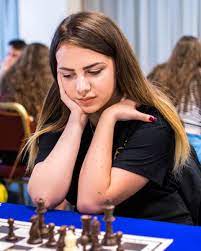
Strength/recent form
Last, but not least, we have arrived at the final and the lowest-rated participant in the Candidates tournament. Just like with Nijat Abasov in the Open section, I think it is fair to say Salimova is objectively, the weakest player in the field, given that she is currently rated 2432 – 43 points lower than Vaishali and 88 points lower than Tan and Muzychuk.
True, her amazing performance in the Women’s World Cup 2023 did demonstrate she is capable of competing – and beating – the world’s best players. But let’s not forget World Cup is a fundamentally different kind of tournament compared to the Candidates. Besides, Salimova wasn’t able to demonstrate her superiority in the classical portion, given that she won her matches against Medina Warda Aulia, Polina Shuvalova, and Anna Muzychuk only in the tiebreak portion.
True, even after the World Cup, Salimova has had good performances in the European Team Championship 2023 (which Bulgaria ended up winning) and Reykjavik Open 2024, so she will surely arrive in Toronto in a good mood/form. However, I do feel no amount of good mood/form can compensate for the difference in playing strength.
And experience. This leads me to the following point.
Nerves/Experience
Just like Vaishali, Salimova has no experience playing events of this caliber. One could even make an argument she has even less experience since Vaishali did get invitations to some high-level closed events, such as Tata Steel 2023 or the aforementioned Prague Challengers 2023. 34
On the other hand, her performance in the World Cup did indicate her nerves might not be affected by a lack of experience. In general, she strikes me as a rather solid and composed player, but we will see how things will play out in Toronto, this April.
Head-to-head score against the other participants
Salimova’s head-to-head score against the other participants is, as follows:
- Salimova – Goryachkina: +0-0=3
- Salimova – Lei: +0-0=0
- Salimova – Koneru: +0-0=0
- Salimova – Lagno: +0-0=0
- Salimova – Tan: +0-0=0
- Salimova – Muzychuk: +0-0=3
- Salimova – Vaishali: +0-0=0
As expected, Salimova has not played many games against other participants in the tournament. She has some experience against Goryachkina and Muzychuk since she faced them in the World Cup. But it was somewhat surprising to see “all zeroes” next to the name of every other player. In particular Vaishali, given that these two are comparatively close in age and given that they both revolved in the 2400 rating heights for a while.
All in all, despite her great performance in the World Cup and her strong display of nerves in that tournament, I still think she will have a hard time in Toronto, given her rating and lack of experience. Thus, I have decided to put her in the last place in my prediction.
My Prediction
- Aleksandra Goryachkina
- Tingjie Lei
- Zhongyi Tan
- Kateryna Lagno
- Anna Muzychuk
- Humphy Koneru
- Vaishali Rameshbabu
- Nurgyul Salimova
- Which is fundamentally different compared to the 120 minutes for the first 40 moves, followed by an additional 30 minutes for the rest of the game, with increment starting only from move 41 used in the “Open” event”.
- So that their games end earlier, which would theoretically give them sufficient time for interviews and give proper attention to the Female players. However, I don’t want to enter the whole debate about whether having a female tournament alongside “male” is good or bad for the publicity of that tournament, as that is way above my pay grade and understanding.
- And preferably the one used in the Women’s Candidates tournament, given that many participants in the Candidates Tournament were complaining about the weird 120 minutes but no increment stuff. If the logic is that the no-increment clause makes games more exciting in the time-trouble phase – then why not use it in the Women’s Candidates Tournament?
- Do note that Aleksandra Goryachkina was the ultimate winner of the Women’s Chess World Cup 2023. But since she already qualified for the Candidates through different means (Women’s Grand Prix), the qualification spots were awarded to the next two best players in the World Cup)
- The spot was awarded to her since the second place winner Anna Muzychuk already qualified via the World Cup
- The female Alireza?
- Apart from Judit Polgar, Hou Yifan, Ju Wenjun, and two other participants in this event – Anna Muzychuk and Humphy Koneru
- Due to her dominance over her female competitors – most notably in the Candidates Tournament 2020. But also due to her participation in elite male events, such as the Russian Superfinal, for which she had to undergo a tough qualification in the Russian Higher League
- These statistics were taken from the website www.chessgames.com and refer to the classical encounters between these players. This data also relies on the chessgames database and might miss a game or two. However, for the purpose of painting an overall picture, I will consider it sufficient.
- Or even Lagno’s or Koneru’s. Although I do somehow consider Goryachkina and Lei to be in a higher “tier” of favourites
- Behind Hou Yifan, Ju Wenjun, and Alexandra Goryachkina
- Born in 1997
- Okay, these were COVID years and COVID was particularly hard in China, but still.
- Her last event was precisely the World Championship match against Ju Wenjun
- Born in 1997, just one year younger than Goryachkina
- Losing the 12th game with the result standing at 5.5-5.5
- This is not only my impression. In the most recent episode of Perpetual Chess Podcast, GM Rafael Leitiao singled out her and Goryachkina as the players with the best nerves.
- Despite having several breaks – most recently a two-year gap between 2017 and 2019 due to maternity leave
- Although she did withdraw due to medical issues after only 4 rounds
- Btw, it is kinda telling that participants in the Women’s Candidates have to participate in open tournaments a month before the tournament begins (Salimova also played in Reykjavik Open 2024).
- But rather evidence of temporary lack of form or, say, rating deflation
- To the disillusionment of many “adult improvers” out there
- Where she got beaten convincingly. But there is no shame in losing to the 2nd best female player of all time
- Although it is hard to blame her for the results in the 2008 and 2010 editions, given she was eliminated by Hou Yifan both times
- Note, btw, that this knockout championship was held in the very same year as the Ju-Tan 2018 World Chess Championship Match. Meaning that Ju Wenjun had to defend the title twice in the same year. I didn’t realize what a mess the Women’s World Championship has been so recently.
- Where all four classical games were drawn and where Tan ultimately prevailed in the rapid tiebreak.
- Who wasn’t?
- I know, I know – I am starting to sound like a broken record.
- Polgar, Hou, Koneru, Ju, and Goryachkina are the other five
- I have tried to stay away from that topic deliberately in this article. But it can’t be completely ignored in Muzychuk’s case. It will be interesting to see how she will behave in her games against Goryachkina and Lagno, who participated in events organized by Sergey Karjakin in recent years.
- This tells as much about the age of these players as about how messy Women’s World Championship Cycles have been. But I am being a broken record again
- It is one thing playing in the FIDE Grand Swiss and in Candidates, as in the latter direct preparation for specific players plays a much more important role
- Comparatively speaking
- TBH, I do feel Vaishali gets more opportunities than some other players (such as Assaubayeva, Khademalsharieh, Abdumalik, Zhu Jiner, Wagner – and even Salimova – and I can’t fully understand why. High profile? Hype? It is understandable due to her recent strides, but why she got an advantage over some other players when it comes to, say, Tata Steel last year (when she was rated “only” 2425) is beyond me. Although I guess this just shows women get too few opportunities, in general.

